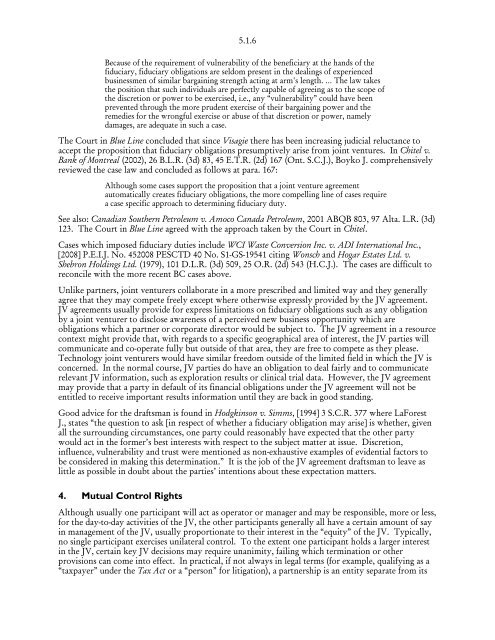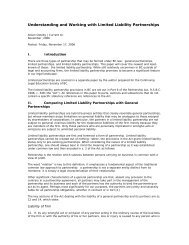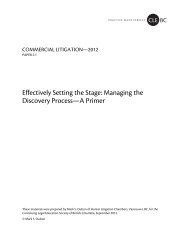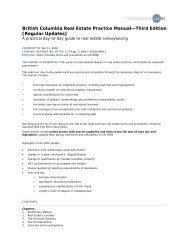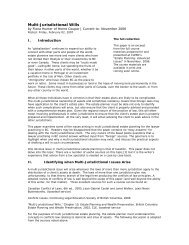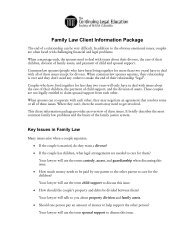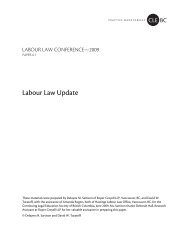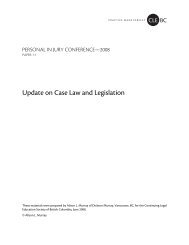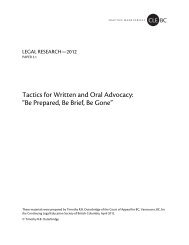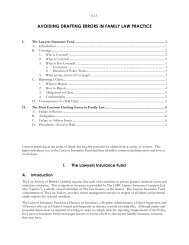Joint Ventures-The Limited Fiduciary Relationship Structure
Joint Ventures-The Limited Fiduciary Relationship Structure
Joint Ventures-The Limited Fiduciary Relationship Structure
Create successful ePaper yourself
Turn your PDF publications into a flip-book with our unique Google optimized e-Paper software.
5.1.6<br />
Because of the requirement of vulnerability of the beneficiary at the hands of the<br />
fiduciary, fiduciary obligations are seldom present in the dealings of experienced<br />
businessmen of similar bargaining strength acting at arm's length. … <strong>The</strong> law takes<br />
the position that such individuals are perfectly capable of agreeing as to the scope of<br />
the discretion or power to be exercised, i.e., any “vulnerability” could have been<br />
prevented through the more prudent exercise of their bargaining power and the<br />
remedies for the wrongful exercise or abuse of that discretion or power, namely<br />
damages, are adequate in such a case.<br />
<strong>The</strong> Court in Blue Line concluded that since Visagie there has been increasing judicial reluctance to<br />
accept the proposition that fiduciary obligations presumptively arise from joint ventures. In Chitel v.<br />
Bank of Montreal (2002), 26 B.L.R. (3d) 83, 45 E.T.R. (2d) 167 (Ont. S.C.J.), Boyko J. comprehensively<br />
reviewed the case law and concluded as follows at para. 167:<br />
Although some cases support the proposition that a joint venture agreement<br />
automatically creates fiduciary obligations, the more compelling line of cases require<br />
a case specific approach to determining fiduciary duty.<br />
See also: Canadian Southern Petroleum v. Amoco Canada Petroleum, 2001 ABQB 803, 97 Alta. L.R. (3d)<br />
123. <strong>The</strong> Court in Blue Line agreed with the approach taken by the Court in Chitel.<br />
Cases which imposed fiduciary duties include WCI Waste Conversion Inc. v. ADI International Inc.,<br />
[2008] P.E.I.J. No. 452008 PESCTD 40 No. S1-GS-19541 citing Wonsch and Hogar Estates Ltd. v.<br />
Shebron Holdings Ltd. (1979), 101 D.L.R. (3d) 509, 25 O.R. (2d) 543 (H.C.J.). <strong>The</strong> cases are difficult to<br />
reconcile with the more recent BC cases above.<br />
Unlike partners, joint venturers collaborate in a more prescribed and limited way and they generally<br />
agree that they may compete freely except where otherwise expressly provided by the JV agreement.<br />
JV agreements usually provide for express limitations on fiduciary obligations such as any obligation<br />
by a joint venturer to disclose awareness of a perceived new business opportunity which are<br />
obligations which a partner or corporate director would be subject to. <strong>The</strong> JV agreement in a resource<br />
context might provide that, with regards to a specific geographical area of interest, the JV parties will<br />
communicate and co-operate fully but outside of that area, they are free to compete as they please.<br />
Technology joint venturers would have similar freedom outside of the limited field in which the JV is<br />
concerned. In the normal course, JV parties do have an obligation to deal fairly and to communicate<br />
relevant JV information, such as exploration results or clinical trial data. However, the JV agreement<br />
may provide that a party in default of its financial obligations under the JV agreement will not be<br />
entitled to receive important results information until they are back in good standing.<br />
Good advice for the draftsman is found in Hodgkinson v. Simms, [1994] 3 S.C.R. 377 where LaForest<br />
J., states “the question to ask [in respect of whether a fiduciary obligation may arise] is whether, given<br />
all the surrounding circumstances, one party could reasonably have expected that the other party<br />
would act in the former’s best interests with respect to the subject matter at issue. Discretion,<br />
influence, vulnerability and trust were mentioned as non-exhaustive examples of evidential factors to<br />
be considered in making this determination.” It is the job of the JV agreement draftsman to leave as<br />
little as possible in doubt about the parties’ intentions about these expectation matters.<br />
4. Mutual Control Rights<br />
Although usually one participant will act as operator or manager and may be responsible, more or less,<br />
for the day-to-day activities of the JV, the other participants generally all have a certain amount of say<br />
in management of the JV, usually proportionate to their interest in the “equity” of the JV. Typically,<br />
no single participant exercises unilateral control. To the extent one participant holds a larger interest<br />
in the JV, certain key JV decisions may require unanimity, failing which termination or other<br />
provisions can come into effect. In practical, if not always in legal terms (for example, qualifying as a<br />
“taxpayer” under the Tax Act or a “person” for litigation), a partnership is an entity separate from its


